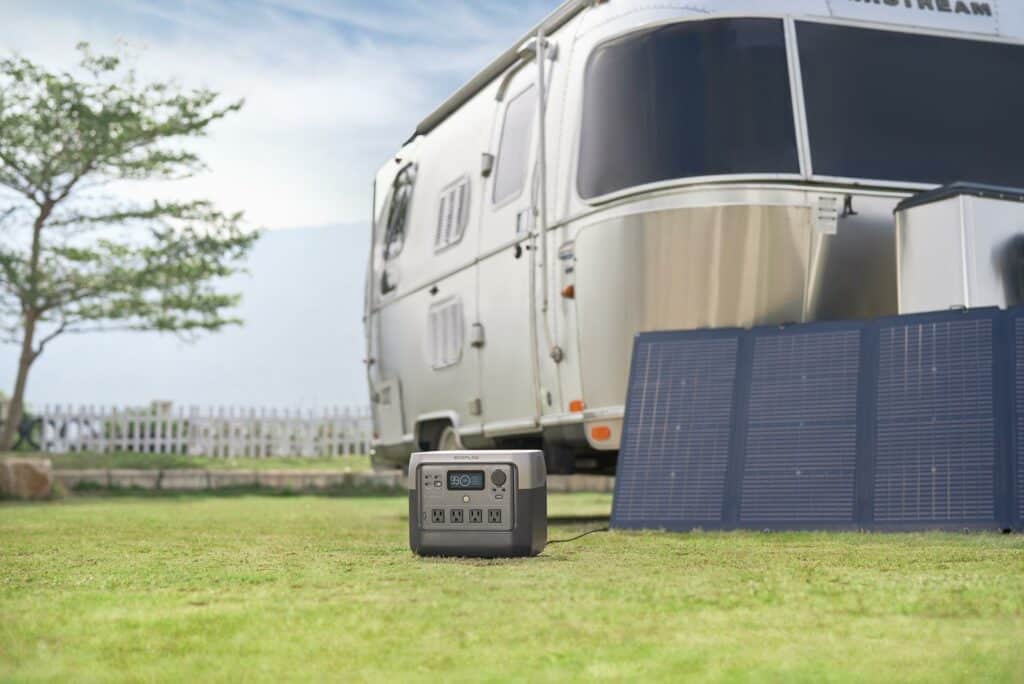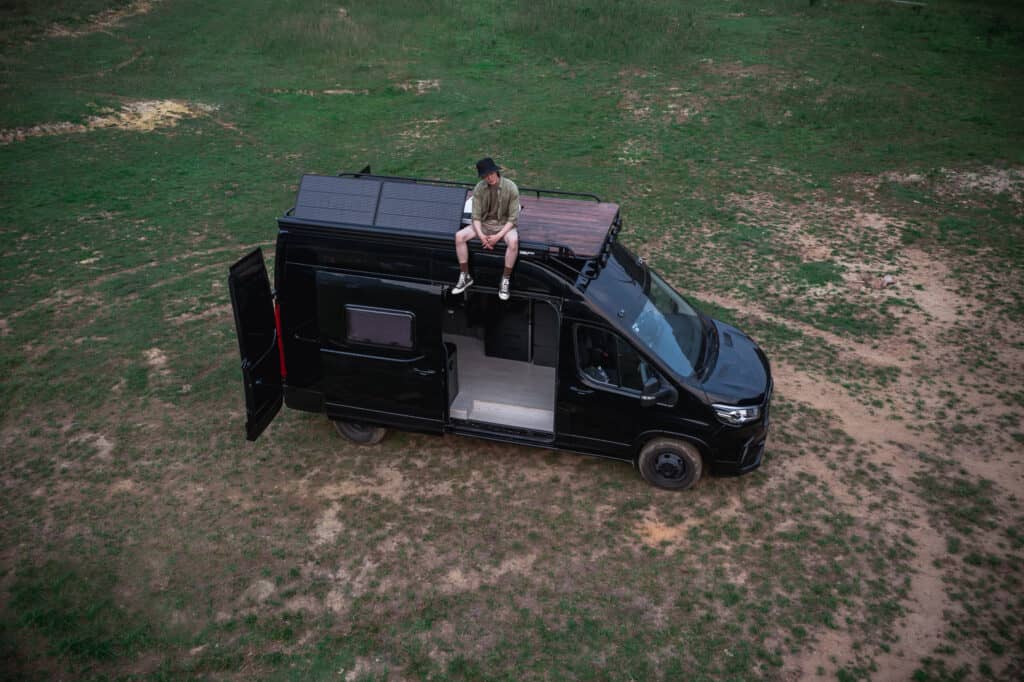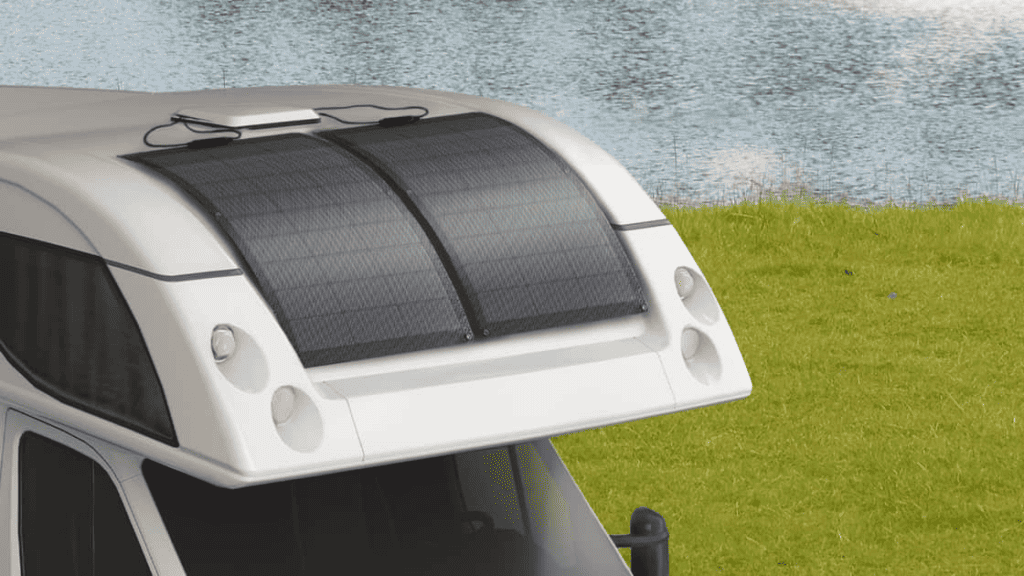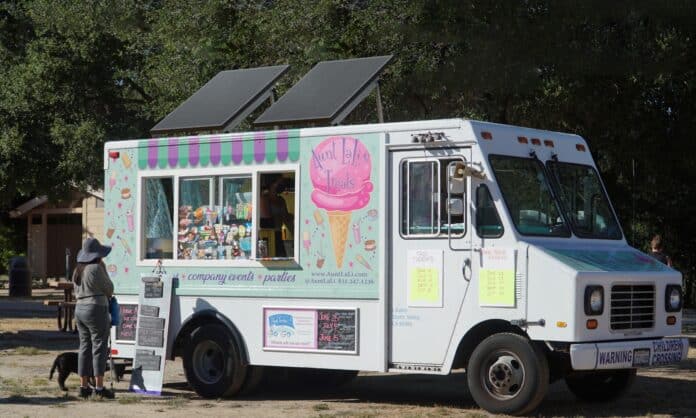Table of Contents
Want to turn up the heat in your food truck using the power of the sun?
Whatever street food you’re serving up, it’s sure to taste better if you (and your customers) know it’s been made using sustainable energy.
Thanks to significant advancements in solar technology, running your food truck’s electrical appliances on solar power is now possible.
Check out what you must consider before switching to solar, how many photovoltaic (PV) panels you’ll need, and more.
Read on to find out how to serve up food truck grub — sustainably!

Can Solar Panels Power a Food Truck?
The short answer?
Absolutely.
Be smart about your setup, purchase solar panels with a sufficient rated power output — and the right balance of system to match — and you can meet 100% of your food truck’s electrical appliance needs with solar power. And enjoy all of the benefits that come with it!
To make this work, you need some basic knowledge about electricity and solar power…
But don’t panic!
Here’s everything you need to know about running your food truck on clean, renewable solar energy.

How Many Solar Panels Do You Need To Power a Food Truck?
The number of panels you need comes down to your unique electricity consumption requirements, the type, and the rated power of the solar panels you install.
A few things you need to know about solar panels.
All solar panels have a rated power wattage — typically between 100W and 400W per panel. This represents the maximum amount of electricity your PV panel can generate.
Remember, rated power measures a maximum — it’s not a guarantee. In fact, your solar panels will rarely reach their rated output wattage because they’ll rarely operate in ideal conditions.
Factors that impact the amount of electricity your panels generate include efficiency, orientation and angle, temperature, shading, and more.
Here’s a simple formula to help you estimate how much electricity your solar panels will produce:
P (rated power in Watts) x H (number of peak sunlight hours) = Total energy output (measured in Wh)
The resulting figure will help you to estimate the number of solar panels you need. Of course, this is an estimate, and actual power generation may vary, but it’s a good rule of thumb.
Don’t know how many hours of peak sunlight to expect?
Let’s say you use EcoFlow’s RIVER 2 Pro w/220W solar panel and typically receive 4 hours of peak sunlight daily. You could reasonably estimate that around 880Wh of electricity will be produced daily.
Unless you’re only running a small number of appliances — like a food processor or hand blender — and not simultaneously, RIVER 2 Pro won’t give you the off-grid electricity you need. It’s a great option if your off-grid power needs are minimal, though!
If you want to run multiple high-wattage appliances at once — like your refrigerator/oven/microwave etc. — you’ll need something more substantial.
The DELTA Pro w/400W solar panel can produce 1,600Wh (or 1.6kWh) of electricity daily by capturing the same 4 hours of peak sunlight per day.
Also, unlike the RIVER 2, you can add up to 4 x 400W rigid or portable solar panels to quadruple your electricity generation capacity.
To estimate how many solar panels you’ll need to power your food truck, you need to calculate your average electricity consumption accurately.
That means totalling up the running and starting watts of all the devices and appliances you need to operate simultaneously.
Here’s how you do it:
- Identify the wattage requirements of your appliances. Survey the starting and running wattage requirements of the appliances and devices you plan to plug into the generator. You can usually find the wattage requirements labelled on the appliance, but, to give you a rough idea, we’ve also compiled the starting and running watts of typical household appliances in the table below.
- Convert volts/amps to watts. If your appliance’s power requirements are in volts or amps, you can calculate an appliance’s running watts with this equation:
Volts (V) x Amps (A) = Watts (W)
- Count the running watts of your appliances. Add up the running watts of the appliances you plan to use — does the total exceed the running watts listed on your generator? If so, consider buying a generator with more output capacity.
- Factor in starting watt requirements. Identify the appliance with the highest starting wattage. Add that appliance’s starting wattage to the running wattage total.
- Calculate the sum. That final number is the total starting watts you need from your generator. As discussed above, to avoid overloading your generator, do not exceed its starting watts rating.
Starting and Running Watts of Typical Food Truck Appliances (Estimates Only)
| Appliance | Rated (Running) Watts | Starting Watts |
| Home Refrigerator/Freezer | 700 | 2200 |
| Light Bulb | 60-75 | 0 |
| Microwave | 600-1000 | 0 |
| Toaster | 900 | 0 |
| Coffee Maker | 1000 | 0 |
| Blender | 300 | 800 |
| Toaster Oven | 1200 | 0 |
| Space Heater | 2000 | 0 |
| Laptop | 50-300 | 0 |
| 20” Box Fan | 200 | 350 |
Once you know your electricity consumption requirements, invest in a generator with at least 10% more power output than you need.
Additional AC output gives you room to grow and allows you a margin of error.

What To Consider Before Using Solar Panels on a Food Truck
Before making the decision to switch to solar power to operate your food truck, there are some crucial factors to consider.
Here are some key points to remember when considering the choice to switch and making your off-grid electricity purchase decision.
Location of Your Food Truck
You already know that where you park your food truck has a huge impact on your revenue.
They say “Location, Location, Location” for a reason.
But where you park your truck during operations will also have a substantial impact on your ability to generate off-grid electricity.
Regardless of what system, how much electricity you actually produce depends substantially on the hours of peak sunlight your PV panels receive.
Estimate how many hours of peak (direct) sunlight your solar panels will receive each day.
Obviously, all you can do is estimate. There will be cloudy and sunny days. Using the average peak sun hours for your location and taking into consideration any ongoing external factors — for example, shade — will help you come to a realistic estimate of how much sun your panels will receive each day.
Let’s say you have the EcoFlow DELTA 2 w/220W solar panel. Your panels can produce a maximum of 220W of electricity per hour under ideal conditions. But they won’t get anywhere near that if they’re not exposed to direct sunlight.
If your truck doesn’t receive several hours of peak sunlight daily, you might want to pick a new go-to location for your food truck or rethink going solar.
A more realistic option than going fully renewable might be switching a portion of your truck’s electricity consumption requirements to solar — not the whole operation.
Electricity Requirements
The more energy your food truck consumes, the more solar panels you’ll need.
However, it’s essential to understand that you can’t just chain together an endless number of solar panels to achieve your electricity generation goals. Almost NO appliance* can operate using PV panels alone.
Solar panels capture energy from the sun, but they require a portable power station or other balance of system to convert sun rays into usable electricity.
Essential components that all off-grid solar power solutions using lithium-ion or LiFePO4 batteries must have (regardless of manufacturer) include:
If you’re using a portable power station or solar generator, the solar charge capacity (or input capacity) determines the total number of solar panels you can chain together without upsizing or expanding your system.
For most food trucks to meet a substantial portion of their electricity consumption needs, the entry-level EcoFlow solar generator is likely the DELTA 2 w/220W Bifacial Portable Solar Panel. With 500W solar input, you can add another 220W Bifacial Solar Panel or even a 400W rigid solar panel on your food truck’s roof.
Keep in mind, even if you have 620W of solar input (220W panel +400W panel), your PV panels are unlikely to produce their maximum rated power for extended periods. But, combined, they are likely to reach your solar input maximum of 500W per hour.
Even if the panels generate more than the solar charge capacity, that’s the maximum that your portable power station will process. Any additional wattage will just dissipate.
If the DELTA 2 is unlikely to generate sufficient electricity, check out the DELTA Max and DELTA Pro. Both are highly expandable in terms of storage and number of solar panels — either one could meet your needs.
Still not enough?
Time to bring in the big guns.

If you have a well-established food truck operation that runs like a well-oiled machine, EcoFlow’s Power Kits could be the ultimate off-grid electricity solution for you.
Designed to be permanently installed in a food truck or motorhome, Power Kits range from 2kWh to 15kWh of AC storage capacity, 3600W of AC output (Surge 7200W), and massive solar input of 4800W.
That means you could connect up to 12 x 400W rigid and/or portable solar panels. Or you can customise your solar array by adding 100W flexible solar panels to maximise your exterior surface areas.

Flexible solar panels are designed to be affixed to irregular and curved shapes commonly found on food trucks and motorhomes.
Power Kits aren’t cheap. But your investment could pay off substantially over time. If you’re just getting started in the food truck business, you should probably play it safe with a less capital-intensive solution.
But if you’re looking to maximise an established food truck’s profitability (and sustainability) over the long term, Power Kits could be the perfect fit.
Check out the online calculator and see what a customised Power Kit could do for your food truck business.
* One notable exception to this rule is EcoFlow’s GLACIER Portable Refrigerator. Designed more for recreational use, its compact build, fast cooling, and ice-making could also be a solid addition to your food truck kitchen. Direct solar charging is just one of the unique features GLACIER offers in a portable fridge.
Budget
No matter whether you’re starting up your food truck business or operating successfully for some time, budget is a huge determining factor when looking at off-grid electricity alternatives.
Consider the upfront cost and your long-term savings on petrol or other electricity supplies like on-site hookups. You can use this guide to determine your solar payback period. Once your savings on electricity exceed your costs, the money you save is money in your pocket.
If the upfront cost is holding you back — and that’s the case for many business owners like you — many manufacturers have low-to-no-interest financing options.
Here’s another essential point to consider.
The move towards a net-zero, decarbonised future is a global imperative.
No matter where you live, government programs are undoubtedly available to incentivise you to switch to solar. Many of these programs, like the Federal Solar Tax Credit, are geared toward residential homeowners.
But there are also tax incentives available for small businesses. Do your research before deciding on switching to solar. You may not get free solar panels, but the right government program could help make the cost of your solar transition much less prohibitive.

Benefits of Using Solar Panels on a Food Truck
Many good things come from using clean, renewable solar energy to power your food truck.
Let’s go over some of the benefits below:
Cost-Effective Source of Electricity
After your initial investment in a renewable off-grid electricity solution, you can say goodbye to fossil fuel bills and costly on-site hookups, at least for electricity generation.
Let’s face it; there simply isn’t a viable renewable energy alternative for your propane grill and stove. You can’t currently replicate the Maillard reaction — that priceless char — with a solar-powered appliance. But you can use it for just about everything else.
If sustainability is important to you, propane is much cleaner burning than gas or diesel. You can even use a Smart Generator Dual Fuel running on propane as a last line of defence for your solar power system. Restrict your fossil fuel use to LPG for your grill, and you’ll still make significant strides toward reducing your carbon footprint.
Eco-Friendly
We all know fossil fuel generators aren’t good for the environment. They’re also noisy, emit toxic, foul-smelling fumes, and are restricted from operating in many locations.
Do your part to combat adverse effects on our planet by making the change to sustainable electricity generation.
Solar generators provide an alternative energy source to keep your appliances running, and making the switch can also help save the planet.
Consumers Value Sustainability
Consumers value sustainability. Going solar can help boost your food truck’s brand by showing you care about our planet’s future.
Don’t be shy about making your solar transition public. Share it on your socials and your signage.
Some food truck owners have even had marketing success with a slight price increase to let your customers know that they’re contributing to your transition to a more eco-friendly, sustainable business.
Even when your investment in solar pays off in the long run, it’s still no easy feat. Don’t be afraid to blow your own horn.

Final Thoughts
Whether you’re starting up your food truck business or transitioning a profitable operation to solar, making the switch to renewable energy is never the easy choice.
Maintaining the status quo — or taking the quickest, cheapest route — is always simpler than choosing an alternative path, even if it’s the more viable choice in the long term.
Carefully consider all the factors above and crunch the numbers.
Even if you don’t switch all of your electricity generation to solar, there’s probably an advantageous way to switch a sizeable chunk.
Your customers, your bottom line, and our planet will thank you for it.
If you’re ready to start checking out renewable off-grid electricity solutions for your business, check out our roundup of the five best generators for food trucks in 2023.
No matter what you decide, best of luck with your business!
